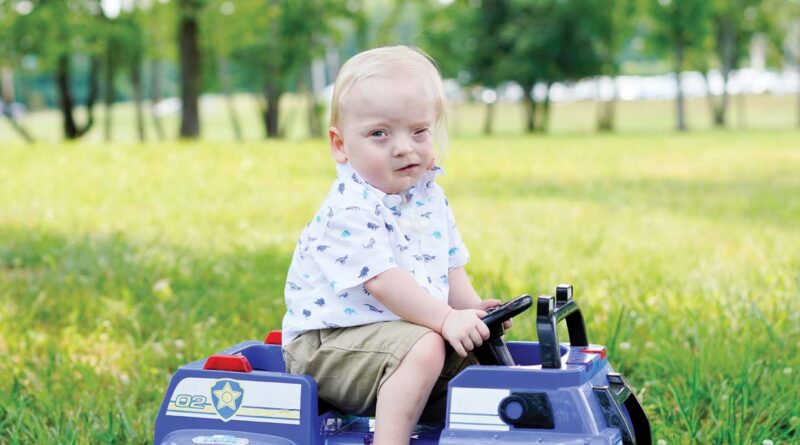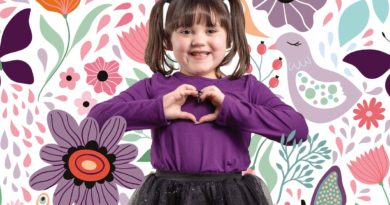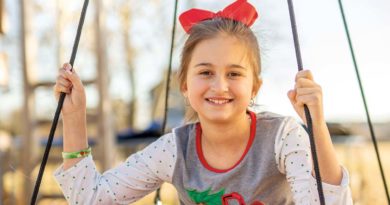Face Time
Published on September 15th, 2020 by Christina Echegaray.
Three days after having his skull surgically reconstructed last year, Colton Haywood was upright and reaching for the colorful toys attached to his stand-and-play activity center.
The unexpectedly rapid recovery didn’t surprise his parents, who marvel at their young son’s spirit and determination.
“From the point when my water broke at 19 weeks and the doctors said he would probably be (in a vegetative state) to now…he runs; he plays; he gets into everything,” says Colton’s mother, Erin Haywood. “He’s such a blessing. We’ve gone from no hope to hope.”
Colton, who turned 2 in March, was born at 27 weeks’ gestation.
Prenatal ultrasounds had not revealed that the left side of his skull and face did not fully develop, a condition called craniofacial microsomia. He had a cleft lip and palate (a split in the upper lip and roof of the mouth), malformation of the left eye and eyelids, a missing left ear and part of the jaw, and craniosynostosis — an abnormal fusion of the skull growth plates which can restrict brain growth.
A team of specialists in the Cleft and Craniofacial Program at Monroe Carell Jr. Children’s Hospital at Vanderbilt has cared for the Gallatin, Tennessee, toddler since his birth.
At three months, he had a tracheostomy and gastrostomy tube inserted. He’s had multiple surgeries to repair the cleft lip and palate, a bilateral hernia and the craniosynostosis.
“Vanderbilt has been absolutely perfect with us, helping us walk through every step that he’s had to go through,” Erin Haywood says. “It’s been crazy. There were so many times that we didn’t think he was going to make it.”
But then Colton would bounce back quickly following a surgery, she says. “He’s come through so much. Yes, he has some limitations, but you can’t tell him that. If he sees everybody else doing something, he wants to do it too.”
A team of experts
The Vanderbilt Cleft and Craniofacial Program uses a multidisciplinary team approach to care for children with facial differences including cleft lip and palate and other craniofacial disorders.
“Our overarching goal is to have a unified program that leverages the complementary strengths of all the different specialists who take care of these kiddos,” says Michael Golinko, MD, medical director of the Cleft and Craniofacial Program and chief of Pediatric Plastic Surgery. “That’s plastic surgery, otolaryngology, head and neck surgery, neurosurgery, oral and maxillofacial surgery, hearing and speech, genetics, dental and more … it’s many different kinds of clinicians. At Vanderbilt, we have the advantage of having an integrated team in the same building on the same campus.”
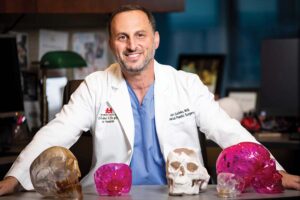
Golinko, who is also assistant professor of Plastic Surgery, sits on the edge of the seat in his Children’s Hospital office. He talks fast and rapidly clicks from one slide to the next on his computer screen, describing patients he has treated to illustrate the types of patients the program serves. The patients range from those with cleft lip and palate — alone or in combination — to skull and jaw abnormalities to skull and facial trauma from dog bites, bullet wounds and crush injuries.
The bookshelves in Golinko’s office contain 3D models of patient skulls, which are produced from computed tomography (CT) imaging for every patient who has a skeletal abnormality.
He picks up one of the models. The skull looks like it has been stretched out on one side.
“This patient has a lipofibromatosis, which is an overgrowth of the soft tissue that is deforming the bone,” Golinko says. “These kinds of complex abnormalities require a team of experts who can apply different principles to these unique surgical problems.”
Vanderbilt’s experts have been treating cleft and craniofacial disorders for more than 30 years. The program was founded by Emeritus Co-Director Kevin Kelly, MD, DDS, associate professor of Plastic Surgery, who continues to treat patients.
Prenatal-to-prom
Golinko joined Children’s Hospital as the program’s director in 2018 with the goal of establishing it as a “destination program,” he says. He has worked with cleft team co-director James Phillips, MD, program lead Clare Gargaro, PA-C, and nurse coordinator Laura West, LPN, to set up team clinics, where patients see their entire care team all in one day in one location.
The program has a “prenatal-to-prom” approach. The team begins planning treatment before patients are born when possible — if cleft or craniofacial anomalies are detected prenatally — and sees patients through all the surgical procedures and therapies they need into the high school years and young adulthood.
The team also has an annual meeting with families to plan for the year.
Improving outcomes, sharing results
Operate, innovate, educate. It’s a simple phrase that sums up the mission of the Vanderbilt Cleft and Craniofacial Program, says medical director Michael Golinko, MD.Read more »
“We love the meeting, because you can sit with every doctor and learn what’s going to happen for the year,” says Colton’s father, William Haywood.
“And we love that they give us a book with all of the information, all the aftercare and everything, and later we can do our own research and know what to expect,” adds Erin Haywood. “That book makes everything easier.”
It was at their team meeting in June 2019 that the Haywoods learned that Colton’s frontal skull suture had fused too early and was putting pressure on his brain, a condition called craniosynostosis.
“Colton had been really fussy and throwing up, which wasn’t normal for him,” Erin Haywood says. “Dr. Golinko had a CT done that day and discovered that the suture had fused and there was so much pressure that it was starting to grow the ripples of his brain into the bone.”
For patients with craniosynostosis, surgery is required to expand the skull, relieve the intracranial pressure and allow the brain to grow, Golinko says. In babies as young as 10 weeks, surgeons can use an endoscopic approach to remove a strip of bone. The traditional surgery, which Colton had, is a cranial bone remodeling procedure that involves opening the skull bones and using absorbable polymer plates to create space between and connect the skull bones.
“That was a very, very difficult surgery,” Erin Haywood says. In addition to surgery for craniosynostosis, which was performed by Kelly, Colton has had cleft lip and cleft palate repair surgeries with Phillips, and he will require jaw reconstruction in the future. Despite multiple rounds of genetic analyses and other testing, no cause has been determined for Colton’s craniofacial microsomia.
“You want an answer, but then it’s also OK, because he’s perfect the way he is,” Erin Haywood says.
Powerful tools
Most patients in the Cleft and Craniofacial Program are treated for a cleft (a split) in the lip, palate, or both. A cleft lip and/or palate happens when the tissues that form the lip or palate do not join completely during development because of genetic, environmental or unknown factors. It is the most common facial difference, occurring in about 1 in 700 live births.
On average, a child with a cleft lip and palate requires five or six surgeries, starting at 3 to 5 months of age through high school. Without repair, children would face additional challenges related to feeding, hearing, dental development, speech and self-image.
Vanderbilt is one of the few programs in the region that offers nasoalveolar molding (NAM), a non-surgical way to reshape the nose and mouth tissues before surgery in children with wide clefts. NAM uses a plastic plate similar to an orthodontic retainer to bring the gums together and align the dental arches.
“It looks very scary and intimidating but it’s been great. It’s amazing what it’s done,” says Ashley Anderson, whose son, Judah, had NAM therapy prior to surgery for a wide cleft lip and palate.
Judah, now 15 months old, was diagnosed in utero at a 20-week ultrasound with a cleft lip and palate. His parents, Ashley and David Anderson knew it was a possibility. David also was born with a bilaterial cleft lip and palate, experiencing many surgeries and appointments as a child.
“We knew we would want a team of doctors that work together, and then we found out Vanderbilt had a team and had heard great things,” Ashley said.
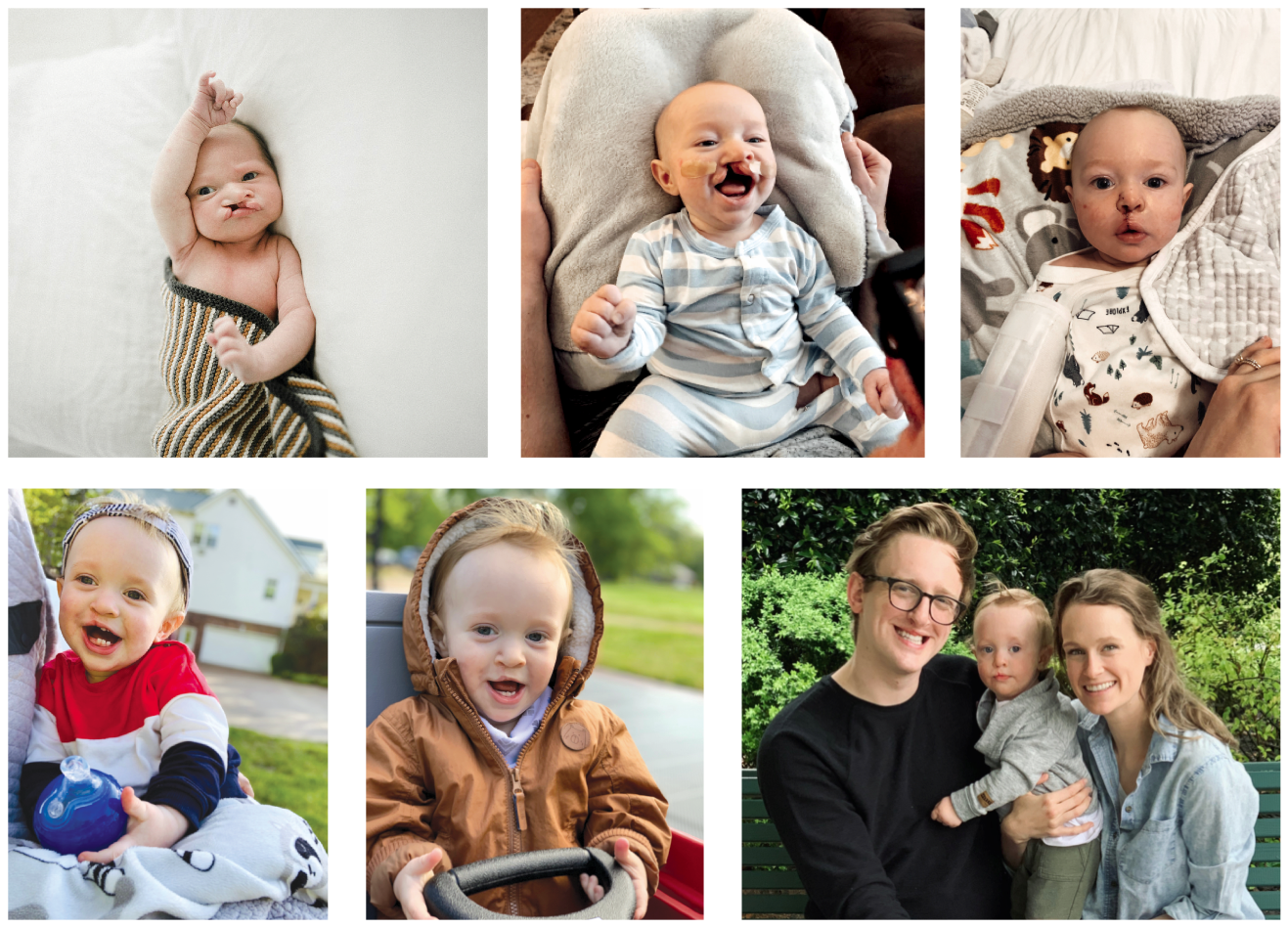
Margaret Maclin, DMD, assistant professor of Clinical Oral & Maxillofacial Surgery, is a pediatric dentist in the program who works with children like Judah undergoing NAM.
“Dr. Maclin has been a huge boon to our program in providing this care,” Golinko says. “NAM is an extremely powerful tool that can potentially reduce the number of surgeries a child will need. We are definitely getting better results with NAM than without it.”
The team immediately assessed Judah following birth to understand the size and scope of his cleft lip and palate. He got his NAM at 2 weeks old, with the Andersons taking Judah weekly to see Maclin for NAM adjustments. He wore the device until he was 4 months old when he had his first surgery to repair his lip and nose. He has had a second surgery since.
Golinko and Phillips have prioritized having dental services integrated in the program because nearly all children with cleft and craniofacial disorders require dental and orthodontic treatments.
“Having a pediatric dentist as part of the group is the difference between a good cleft-craniofacial team and a great team,” Golinko says.
For Maclin, the progress that she sees with each patient is rewarding.
“When they look back through pictures and they say, ‘Oh my gosh, we have made it so far,’ that’s my favorite. (The NAM) doesn’t always decrease the number of surgeries but it makes the surgeries easier, from start to finish, if we can do this in the very beginning.”
The Andersons have the full teams’ support in Judah’s journey.
“It’s definitely a process, but you are never going to be alone in the process. You’re going to have a team of people who are fighting for your child. They’re going to care for you, they’re going to love you and walk this journey hand in hand with you every step of the way,” David said.
The NAM procedure wasn’t available when David was having his cleft lip and palate corrected as a child.
“I think this is going to make (Judah) stronger and make him a better person. I know my husband, David, is one of the strongest people I know,” Ashley said.
Patients at Vanderbilt also benefit from access to specialists in Hearing and Speech Sciences, which has the highest ranked audiology and speech-language pathology graduate programs in the country, according to U.S. News & World Report.
“We have an extremely experienced team here that works with families on speech and hearing and feeding issues,” Phillips says. “Patients work with providers from the Bill Wilkerson Center, one of the top hearing and speech institutions in the nation.”
A culture of caring
Golinko was a third-year medical student when he saw his first cleft lip surgery. He was hooked.
“I had always been drawn to pediatrics and surgery but seeing that operation put me on the pathway to cleft surgery,” he says. “It was like magic. I didn’t even understand what I was seeing, but there was obviously something really special about it…the kind of transformation that you can make in a couple of hours and the difference that can make in a child’s life for years and decades to come.”
At the Vanderbilt Cleft and Craniofacial Program, “we want to be champions for these children and their families,” Golinko says.
“We understand how hard it is to get care and that these children are going to need multiple surgeries and therapists throughout their childhood and into early adulthood,” adds Phillips.
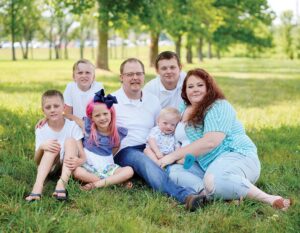
Patients come from the entire Southeast, and Gargaro says the program works to build community among families and to connect them to supportive groups. In the future, the program hopes to offer fun days for the children and educational events for families.
“I can’t think of anything that’s more important or more rewarding than being able to provide reassurance to these families and help them feel like they have a home,” Golinko says.
Colton’s parents have found that home. They know that Colton will require more surgeries, and they’re confident that the Vanderbilt team will see them through his journey.
“They’ll sit with us and answer every single question. They’ll stop in if Colton’s in the hospital for another reason to see how he’s doing. You can tell they’re really caring,” says William Haywood.
Erin Haywood adds, “Everybody works together. It’s like a perfect puzzle. Everybody fits together so well.”
— by Leigh MacMillan
Hope – Summer/Fall 2020

